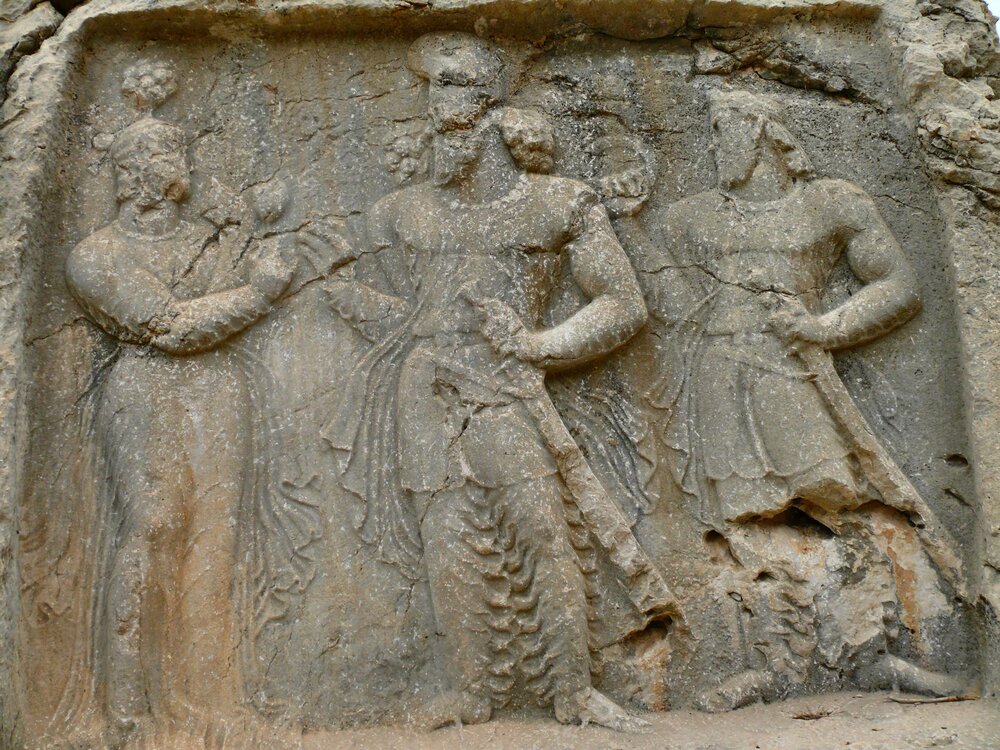Visit Sarab-e Qandil, a puzzling bas-relief of Sassanids

TEHRAN - Reliefs provide important testimony to important moments in both human history and art history. These rock carvings can be seen pretty much everywhere in Iran and even in the world. Who knows, perhaps some of their tales are still untold.
One of them is Sarab-e Qandil, which dates from the Sassanid era (224-651 CE) and is named after the Persian phrase for “ice cold spring.” In the southern province of Fars, close to modern Kazerun, is where the perplexing bas-relief can be found.
A queen is shown giving her husband a lotus flower in the bas-relief, who is generally thought to be the Iranian king Bahram II (r. 276-293)]. A prince holding a powerful ring is likely their son, the future king Bahram III, as the two characters exchange glances.
Like almost Iranian rock reliefs, this one is located near a source of water. The relief is contained in a quadrangular frame, carved on an isolated rock beside the bed of a river, without having been much eroded or damaged by the water.
Its isolation from frequented roads might explain its excellent state of conservation: it was not accessible to vandals.
Special attention has been paid to the clothes. The clothing has received special attention, with lovely and delicate details that evoke a sense of lightness and aerial movement. The crown with the wings and jewels of the king is visible. He is holding his sword in his left hand at the top. His right hand is extended and ready to accept the gift. The composition places the prince on his back and the queen to his left and right, with the royal figure in the middle of the panel.
Attitudes of the king and the queen express love and respect, according to livius.org, which is a website on ancient history written and maintained since 1996 by the Dutch historian Jona Lendering.
“Such representations of love are very rare in Sasanian iconography, which generally consists of audience, victory, or inauguration scenes. An equivalent image of love was carved at Barm-e Dilak, where it is the king who offers the flower to the queen.”
Some experts believe the lack of an inscription cast doubt over the relief’s attribution to Bahram II.
Both the fact that Bahram II was the only Sasanian king to depict his queen on coins and the possibility that the female figure may be dressed more like a queen than a goddess were major points in favor of identification with Bahram II. As a result, academics like Vanden Berghe and Aerinck believe that Bahram II is responsible for the relief. The goddess and Ardashir I are depicted in the relief, according to Lewitt-Tawill, with Shapur I serving as the prince.
Bahram II, the son, and heir apparent of Bahram I had to defend his throne against his brother Hormizd, the viceroy of the eastern provinces, not long after he had been crowned.
As mentioned by the Encyclopedia Britannica, in 283, exploiting Bahram’s preoccupations, the Roman emperor Carus invaded Mesopotamia unopposed and entered Ctesiphon, the Sasanian capital. Carus’ sudden death, however, forced the Romans to withdraw, and soon thereafter, the overthrow of Hormizd made Bahram secure. Numerous southern Persian rock sculptures depict Bahram wearing his winged crown, and several include his queen. Because female portraits are rare in Sasanian art, she is thought to have been a major dynastic personage.
Iran's history places a great deal of significance on the Sassanid era. Persian architecture and art underwent a general renaissance during the Sassanid era. The palaces at Ctesiphon, Firuzabad, and Sarvestan, which are among the ensemble's highlights, are examples of grandiose architecture that frequently adopted oversized proportions.
While the Sassanid state promoted scholarship, highly sophisticated crafts like metalwork and gem engraving developed. Works from the East and the West were translated into Pahlavi, the Sassanian language, during those years. The best examples of Sassanian art can be found in southern Iran at Bishapur, Naqsh-e Rostam, and Naqsh-e Rajab. They are rock-carved sculptures and bas-reliefs on abrupt limestone cliffs.
A collection of Sassanian historical cities in southern Iran, known as the “Sassanid Archaeological Landscape of Fars Region,” was inscribed on the UNESCO World Heritage List in 2018.
AFM
